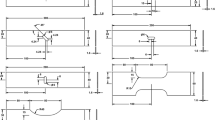Abstract
A new experimental technique has been developed to investigate the onset of fracture in metals at low and intermediate stress triaxialities. The gage section of a flat specimen has been designed such that cracks are most likely to initiate within the specimen center, remote from the specimen boundaries. Along with the specimen, a biaxial testing device has been built to apply a well-defined displacement field to the specimen shoulders. The stress state within the specimen is adjusted by changing the biaxial loading angle. Using this new experimental technique, the crack initiation in metals can be studied experimentally for stress triaxialities ranging from 0.0 to 0.6. The stress and strain fields within the specimen gage section are determined from finite element analysis. The reliability of the computational model of the test set-up has been verified by comparing the simulation results with laser speckle-interferometric displacement measurements during testing. Sample experiments have been performed on the Al-7Si-Mg gravity die casting alloy. A three-step hybrid experimental–numerical calibration procedure has been proposed and applied to determine a phenomenological crack formation criterion for the Al-7Si-Mg alloy.





















Similar content being viewed by others
Notes
A user subroutine has been programmed for the finite element code ABAQUS, which evaluates the damage function [equation (5)] after each time step, thereby providing its value as field variable for postprocessing.
References
Abaqus (2001) ABAQUS reference manuals, Version 6.1. Abaqus Inc., Providence, RI.
Arcan M, Hashin Z, Voloshin A (1978) A method to produce uniform plane-stress states with applications to fiber-reinforced materials. Exp Mech 18:141–146.
Greve L (2003) Development of a PAMCRASH-material model for die casting alloys. In: Proceedings of the 6th international conference magnesium alloys and their applications. Deutsche Gesellschaft für Materialkunde, Wolfsburg.
Gurson A (1977) Continuum theory of ductile rupture by void nucleation and growth: part I—yield criteria and flow rules for porous ductile materials. J Eng Mater Technol 99:2–15.
Henn S (2005) Development of a material model of the crack initiation in aluminum alloys subject to monotonic loading. PhD thesis (in German), University of Karlsruhe.
McClintock FA (1968) A criterion for ductile fracture by the growth of holes In: Transactions of the ASME, J. Appl Mech 363–371.
McKenzie AC, Hancock JW, Brown DK (1977) On the influence of state of stress on ductile failure initiation in high strength steels. Eng Fract Mech 9:167–188.
Mohr D, Doyoyo M (2003) A new method for the biaxial testing of cellular solids. Exp Mech 43(2):173–182.
Mohr D, Doyoyo M (2004) Experimental investigation on the plasticity of hexagonal aluminum honeycomb under multiaxial loading. J Appl Mech 71(3):375–385.
Mohr D, Treitler R (2004) Onset of fracture in high pressure die casting aluminum alloys (submitted for publication).
Rice JR, Tracey DM (1969) On the ductile enlargement of voids in triaxial stress fields. J Mech Phys Solids 17:210–217.
Simo JC, Hughes TJR (1998) Computational inelasticity. Springer, Berlin Heidelberg New York.
Tvergaard V, Needleman A (1984) Analysis of the cup-cone fracture in a round tensile bar. Acta Metall 32(1):157–169.
Acknowledgements
The support of Dr. Stefan Kalke and Dr. Johannes Staeves from the BMW Group is gratefully acknowledged. We thank Professor Tomasz Wierzbicki, MIT, for various discussions. Special thanks are due to Stephen Rudolph, MIT, for his help in designing and machining the testing device as well as the specimens. Thanks are due to Dantec Ettemeyer GmbH for sharing their expertise on speckle interferometry. Furthermore, we are grateful for the help and discussions with our colleagues at BMW Group: Roland Treitler, Mark Jeunnette, Mario Lochmüller, Isabella Rettenbacher and Michael Wesselborg.
Author information
Authors and Affiliations
Corresponding author
Appendix
Appendix
We briefly derive an approximate relationship between the biaxial loading angle and the stress triaxiality in the specimen for a Levy–von Mises plastic material. At a material point in the center of the specimen, the displacement loading may be interpreted as a combination of normal and shear strains. More specifically, we have the plastic normal strain along the y-axis, \(\varepsilon ^{p}_{{yy}} \), and the (engineering) shear strain \( \gamma ^{p}_{{xy}} \) in the x–y-plane, while the ratio of the two strain components is predetermined by the tangent of the biaxial loading angle α (Fig. 1):
Furthermore, we assume that the plastic flow along the x-axis be prohibited:
Summarizing of equations (6) and (7) yields in vector notation
where
The thickness of the specimen is small compared to the specimen width (x-axis) and height (y-axis). Therefore, we consider stress in thickness direction as negligibly small (σ zz ≅ 0) and assume plane stress conditions throughout our analysis. For this special stress state, the flow rule relates the increments in plastic strains to the three non-zero components of the stress tensor (e.g. [12]):
where δ ≥ 0 is the plastic consistency parameter,
Combining equations (8) and (10), we have
Next, we apply the definition of the von Mises equivalent stress, σ v, which yields
where
Analogously, we find for the mean stress σ m
And finally, using equations (13), (14) and (15) we can calculate the stress triaxiality as a function of the biaxial loading angle:
Rights and permissions
About this article
Cite this article
Mohr, D., Henn, S. Calibration of Stress-triaxiality Dependent Crack Formation Criteria: A New Hybrid Experimental–Numerical Method. Exp Mech 47, 805–820 (2007). https://doi.org/10.1007/s11340-007-9039-7
Received:
Accepted:
Published:
Issue Date:
DOI: https://doi.org/10.1007/s11340-007-9039-7




